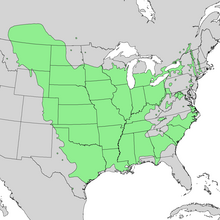Populus deltoides
| Eastern cottonwood | |
|---|---|
 |
|
| Populus deltoides subsp. monilifera | |
| Scientific classification | |
| Kingdom: | Plantae |
| (unranked): | Angiosperms |
| (unranked): | Eudicots |
| (unranked): | Rosids |
| Order: | Malpighiales |
| Family: | Salicaceae |
| Genus: | Populus |
| Section: | Aigeiros |
| Species: | P. deltoides |
| Binomial name | |
|
Populus deltoides W.Bartram ex Humphry Marshall |
|
 |
|
| Native range | |
Populus deltoides, the eastern cottonwood or necklace poplar, is a cottonwood poplar native to North America, growing throughout the eastern, central, and southwestern United States, the southernmost part of eastern Canada, and northeastern Mexico. It is a eudicot.
Populus deltoides is a large tree growing to 20–40 m (65–130 ft) tall and with a trunk up to 1.8 m (5 ft 11 in) diameter, one of the largest North American hardwood trees. The bark is silvery-white, smooth or lightly fissured when young, becoming dark gray and deeply fissured on old trees. The twigs are grayish-yellow and stout, with large triangular leaf scars. The winter buds are slender, pointed, 1–2 centimetres (1⁄2–3⁄4 in) long, yellowish brown, and resinous. It is one of the fastest growing trees in North America. In Mississippi River bottoms, height growth of 10–15 feet (5–5 m) per year for a few years have been seen. Sustained height growth of 5-foot (1.5-meter) height growth and 1-inch (2.5-centimeter) diameter growth per year for 25 years is common.
The leaves are large, deltoid (triangular), 4–10 cm (1 1⁄2–4 in) long and 4–11 cm (1 1⁄2–4 1⁄4 in) broad with a truncated (flattened) base and a petiole 3–12 cm (1 1⁄4–4 3⁄4 in) long. The leaf is very coarsely toothed, the teeth are curved and gland tipped, and the petiole is flat; they are dark green in the summer and turn yellow in the fall (but many cottonwoods in dry locations drop their leaves early from the combination of drought and leaf rust, making their fall color dull or absent). Due to the flat stem of the leaf, the leaf has the tendency to shake from even the slightest breeze. This is one of the identifying characteristics.
...
Wikipedia
